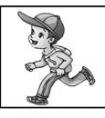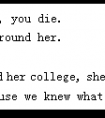句型转换。1. kind, what, they, like, of', would, flood(连词成句) 2.She has a strawberry.(用they替换she) They____ some ____.3.Nancy wants some salad.(同义句转-七年级英语
must + have + 过去分词,表示现在对过去事物的推测。
must 和 have to 的区别:must 表示说话人的主观思想,have to 表示客观需要。
3.need 是一个情态动词,他的用法完全和其他情态动词一样,但 need 还可当作实义动词使用,这时 need 就象其他动词一样,有第三人称,单复数, 后面加带 to 的动词等特性。
needn't + have + 过去分词 表示过去做了没必要做的事情。
4.dare 除用作情态动词外,更多的是当实义动词使用, 用法同实义动词一样,要考虑人称,单复数,时态等。
5.ought 应当,应该。后面跟带有 to 的动词不定式。
ought + to have done 句型。指过去动作,表示一件事情该做而未做。
ought not to have done 句型。表示一件不该做的事情却做了。
6.will (would)决心,愿望。 would 为 will 的过去式,
will, would用于疑问句表示说话人向对方提出请求或询问,用 would 比 will 更婉转,客气。
7.Shall、should 表示命令,警告,允诺,征求,劝告,建议,惊奇。
8.have to,不得不,必须,表示客观条件只能如此,而must 则表示主观思想。
助动词主要有两类:基本助动词和情态助动词。
基本助动词有三个:do,have和be;
情态助动词基本的有十四个:may, might; can, could; will, would; shall, should; must, need, dare, used to, ought to.had better 上述两类助动词的共同特征是,在协助主动词构成限定动词词组时,具有作用词的功能:
1) 构成否定式:
He didn't go and neither did she.
The meeting might not start until 5 o'clock.
2) 构成疑问式或附加疑问式:
Must you leave right now?
You have been learning French for 5 years, haven't you?
3) 构成修辞倒装:
Nowhere can he obtain any information about his sister.
Hardly had he arrived when she started complaining.
4) 代替限定动词词组:
A: Who can solve this crossword puzzle?
B: Tom can.
A: Shall I write to him?
B: Yes, do.
情态动词表推测的用法小结
(一)情态动词表推测的三种句式
1.在肯定句中一般用must (一定),may(可能),might /can, could(也许,或许)。
(1)He must/may/might know the answer to this question?
他一定/可能/也许知道这个问题的答案。
(2)It is cold in the room. They must have turned off the heating.
屋里很冷,他们肯定把暖气关了。
2. 否定句中用can’t / couldn’t(不可能), may not/might not (可能不)。
(1)It can’t/couldn’t be the headmaster. He has gone to America. 这不可能是校长,他去美国了。
(2)He may not/might not know the scientist. 他也许不认识那位科学家。
3. 疑问句中用can/could (能……?)。
(1)Could he have finished the task? 他可能把任务完成了吗?
(2)Can he be at home now? 他现在能在家吗?
注:以上三种句式中情态动词的语气按程度都是依次递减的。Might, could并非may, can的过去式,而表示语气较为委婉或可能性较小。
(二)情态动词表推测的三种时态
1. 对将来情况的推测,用“情态动词 + 动词原形”。
(1)She must / may / might / could arrive before 5. 5: 00 前她一定/可能/也许到。
(2)She must/may/might/could walk miles and miles among the hills without meeting anyone.
她一定/可能/也许会在山里一连走好几英里而遇不到一个人。
2. 对现在或一般情况的推测,用“情态动词 + be”,“情态动词 +be doing”或 “情态动词 + 动词原形”。
(1)He must / may / might / could be listening to the radio now. 他一定/可能/也许正在听收音机。
(2)He can’t ( couldn’t ) / may ( might ) not be at home at this time. 这个时候他不可能/可能不在家。
(3)Mr. Bush is on time for everything .How can ( could ) he be late for the opening ceremony ?
布什先生一向准时,这次开幕式他怎么可能迟到呢?
3.对过去情况的推测,用“情态动词 + have +过去分词”。
(1)It must / may / might / could have rained last night .The ground is wet. 地湿了,昨晚肯定/可能/也许下雨了。
(2)The door was locked. He can ( could ) not / may ( might ) not have been at home . 门锁着,他不可能/可能不在家。
(3)Can / Could he have gotten the book? 难道他找到书了吗?
注:情态动词 should /ought to表推测时,意为“想必会,理应……”但与“have +过去 分词”连用时,则又可构成虚拟语气意为“本应该做某事却没做”。
例如:
(4)It’s seven o’clock. Jack should/ought to be here at any moment.
现在七点钟了,杰克理应随时到达。(推测)
(5)She should / ought to have attended your birthday party, but she had to look after her mother in hospital. (虚拟)
她本该出席你的生日晚会的,可是她得在医院照顾她妈妈。
(6)Tom should not /ought not to have told me your secret, but he meant no harm. (虚拟)
汤姆本不该告诉我你的秘密,可是他并无恶意。
考点名称:一般疑问句
- 一般疑问句:
是疑问句的一种。通常用yes,no来回答的疑问句叫做一般疑问句。口语中若无特殊含义,句末用升调。
其结构是:系动词be/助动词/情态动词+主语+其他成分?
通常回答为:
肯定:Yes+主语+提问的助动词
否定:No+主语+提问的助动词+not
例如:
Are you from Japan? Yes, I am./No, I'm not.
Do you live near your school? Yes, I do./No, I don't.
Can you speak French? Yes, I can./No, I can't. - 一般疑问句的特性:
1.将陈述句变为一般疑问句时,如句中有be 动词(am/ is/ are)时,可直接将它们提至主语前。
如主语为第一人称,应将其改为第二人称。如:
I'm in Class 2Grade 1. →Are you in Class 2Grade 1﹖
We're watching TV. →Are you watching TV﹖
2.陈述句中有情态动词(can、may、must …)时,也可直接将它们提至主语前,即可成为一般疑问句。如:
He can swim now. →Can he swim now﹖
The children may come with us. → May the children come with us﹖
3.陈述句中只有一个实义动词作谓语且其时态为一般现在时,变为一般疑问句时要在句首加do或does主语后的实义动词用原形。如:
I like these animals. →Do you like these animals﹖
She wants to go to the movies. → Does she want to go to the movies﹖
4.一般疑问句一般读升调(↑)
5.一般疑问句有时不用yes或 no 回答。如:
Are they in town now﹖
I think so.
May I sit here﹖
Certainly.
Does he like soccer﹖
Sorry I don't know.
6. 一般疑问句的第一单词总是虚词,读的时候要读轻声。 - 陈述句变为一般疑问句技巧:
根据一般疑问句不同的家族,可以用不同的方法将陈述句变为相应的一般疑问句。
1、第一家族:含be动词或情态动词的句子
秘诀:一调二改三问号
一调:即把句中的be或情态动词调到主语前;
二改:改换主语称谓,即将句中的主语I\my \mines\we\our\ours等。第一人称分别改为相应的第二人称you\your\ yours等;
三问号:句末的句号改为问号。如:
Eg. I am an English teacher. → Are you an English teacher?
Eg. We can speak English fluently. → Can you speak English fluently?
2、第二家族:含行为动词(或称为实义动词)的句子
秘诀:一加二改三问号
一加:即在句首加助动词Do或Does;
二改:1、把谓语动词改为原形;2、改换主语称谓(同第一家组);
三问号:句末的句号改为问号。
Eg. We read English every morning. → Do you read English every morning?
Eg. Tom’s father listens to English on the radio every evening. →Does Tom’s father listen to English on the radio every evening?
特别注意:对于第二家族一定要注意动词的还原,因为时态与数的变化已经体现在助动词上了。
3、加强记忆口诀:
肯变一,并不难,can 或be提在前;
谓语若为行为动,do 或does句首用。
考点名称:特殊疑问句
- 最新内容
- 相关内容
- 网友推荐
- 图文推荐
上一篇:连词成句。(注意标点符号及字母的大、小写)1. a, sell, goods, we, price, these, good, at, very_______________________________. 2. green, they, in, coats, have___-七年级英语
下一篇:为下列句子选择适当的搭配,使句意完整1. It's an ____________________2. There are ____________________3. You can ____________________4. You can sit ___________-七年级英语
零零教育社区:论坛热帖子
| [家长教育] 孩子为什么会和父母感情疏离? (2019-07-14) |
| [教师分享] 给远方姐姐的一封信 (2018-11-07) |
| [教师分享] 伸缩门 (2018-11-07) |
| [教师分享] 回家乡 (2018-11-07) |
| [教师分享] 是风味也是人间 (2018-11-07) |
| [教师分享] 一句格言的启示 (2018-11-07) |
| [教师分享] 无规矩不成方圆 (2018-11-07) |
| [教师分享] 第十届全国教育名家论坛有感(二) (2018-11-07) |
| [教师分享] 贪玩的小狗 (2018-11-07) |
| [教师分享] 未命名文章 (2018-11-07) |






